The HAWK is a medium range, surface-to-air guided missile that provides air defense coverage against low-to-medium-altitude aircraft. It is a mobile, all-weather day and night system. The missile is highly lethal, reliable, and effective against electronic countermeasures. Basic HAWK was developed in the 1950s and initially fielded in 1960. The system has been upgraded through a series of product improvements beginning with the Improved HAWK in 1970. The Phase III product improvement and the latest missile modification were first fielded in the early 1990s to the U.S. Army and U.S. Marine Corps (USMC). Two missile modifications have extended the missile's field life and added electronic counter-countermeasures to defeat special threats. Development was completed on HAWK mobility, the latest system improvement, and it was produced for the USMC and Sweden. The U.S. Army National Guard (ARNG) as well as 20 allied nations, including NATO and several countries in both Southwest Asia and Southeast Asia, were also equipped with the HAWK system. Prime contractor for this system is the Raytheon Company. The cost per missile is $250,000; per fire unit, $15 million; and per battery, $30 million.
Although HAWK missile batteries were deployed by the U.S. Army during the conflicts in Vietnam and Persian Gulf, American troops have never fired this weapon in combat. The first combat use of HAWK occurred in 1967 when Israel successfully fired the missiles during the Six Day War with Egypt. Even though it was not used by the coalition during Operation Desert Storm, the HAWK missile did see action during the Persian Gulf War. Kuwaiti air defense units equipped with U.S. HAWK antiaircraft missiles downed about 22 Iraqi aircraft and one combat helicopter during the invasion of 2 August 1990. The system later posed a possible threat to the U.S.-led coalition because Iraqi forces captured both HAWK and TOW missiles in Kuwait.
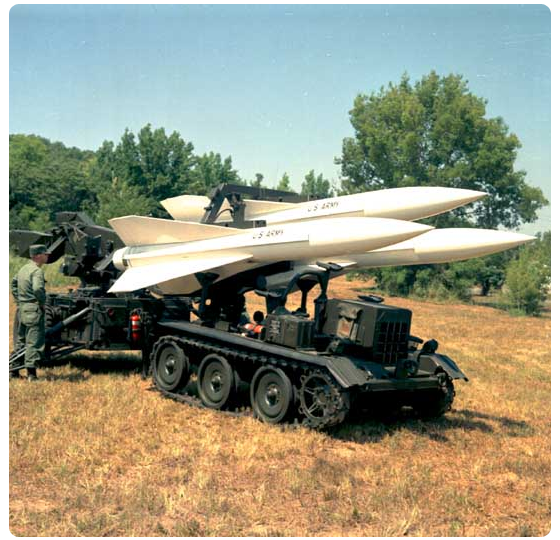
System Chronology
|
23 October 62 Beginning on this date and continuing through 9 November 62, a total of 304 requisitions for HAWK missiles and parts arising from the Cuban missile crisis were processed. The average turnaround time at the contractor's plant was 3 days. December 62 The HAWK Project Manager (PM) submitted a technical development plan for the Improved HAWK. September 63 Raytheon received a contract for a program to demonstrate the feasibility of a modified configuration of the HAWK Assault Fire Unit (AFU). Modified to enhance the mobility of the AFU for use as an interim forward area air defense system for the field Army, this configuration was called the Self-Propelled (SP) HAWK. It had previously been known as the HAWK Improved Mobility or Division HAWK. February - March 65 The Marine Corps' "B" Battery of the 1st Light Anti-Aircraft Missile Battalion deployed with HAWK, marking the first surface-to-air missile system to be placed at the front in the Vietnam War. They were initially positioned on the DaNang airfield and were then placed atop Hill 327 west of the airbase. (Thanks to Jerry Magliano Major, USMC [Ret], and Everett Cowley, Major USMC [Ret], for setting the record straight. Semper Fidelis, men!) March 65 The first HAWK battalion was deployed to Israel. 11 August 65 Raytheon received a letter order contract for a 7-month research & development effort on the SP HAWK. 15 October 65 Two Continental United States (CONUS) Strategic Army Corps Basic HAWK battalions (eight firing batteries) were deployed. The HAWK batteries were never fired in combat, but their radars were used in air defense surveillance. 17 January 66 The revised HAWK improvement program began with the award of a letter order contract to Raytheon. April 66 DA approved military characteristics for the Improved HAWK. February 67 The first ground equipment for the SP HAWK was delivered. June 67 The first combat firings of U.S. Army missiles occurred during the Six Day War, when Israeli troops downed several Egyptian jets with HAWK missiles. July 67 The first SP HAWK production prototype was delivered. September 67 The SP HAWK was type classified limited production. 13 October 67 The U.S. and Japanese governments signed a memorandum of understanding (MOU) for production of the HAWK missile system in Japan. April 68 Raytheon received the first industrial prototype contract for the Improved HAWK. March 69 The SP HAWK was given a statement of suitability for issue to troops in the temperate zone. 29 May 69 Raytheon contracted to adapt the Improved HAWK modifications to the SP HAWK. June 69 The Improved HAWK received a limited production type classification. June 69 The first Improved HAWK production prototype was delivered. June 69 The first SP HAWK unit was equipped. August 69 Raytheon delivered the final SP HAWK major item. July 70 Type classification limited production-urgent was approved for the Improved HAWK. August 70 The first production contract for Improved HAWK tactical equipment was awarded. 17 August 71 All activity on the improved SP launcher was terminated. 21 December 71 The Improved HAWK system was type classified Standard A. May 72 Improved HAWK support items were first deployed to Germany. July 72 The Imperial Iranian Air Force signed a foreign military sales (FMS) case for 24 batteries of Improved HAWK materiel totaling nearly $280 million, one of the largest sales of missile materiel that MICOM had ever negotiated with a foreign country. October 72 The first Improved HAWK battalion was equipped, achieving initial operational capability (IOC). 13 October 72 AMC approved the conditional release (temperate zone) of the Improved HAWK. 6 November 72 The first Improved HAWK battalion-the 2d/62d Air Defense Artillery Battalion-was activated in Bitburg, Germany. June 73 The first battery of Improved HAWK missile equipment refurbished at Pueblo Army Depot was delivered to U.S. troops in Europe. 2 December 74 The first U.S. Army Forces Command (FORSCOM) Improved HAWK battalion-the 1st/7th Air Defense Artillery (ADA) Battalion-was activated at Fort Bliss, Texas. August 75 The initial conversion of a Basic HAWK battalion in Korea to the Improved HAWK configuration involved two batteries of the 2d Battalion/1st Air Defense Artillery. September 76 The first PEACE SHIELD (as the HAWK-Iran program was known) manager reported to Iran. FY 77 The conversion from Basic HAWK to the Improved HAWK configuration was completed for U.S.-deployed battalions in Europe & Korea. 2 June 77 A breadboard firing at White Sands Missile Range (WSMR) demonstrated the compatibility of Improved HAWK and PATRIOT in a severe countermeasures environment. The PATRIOT system acquired the first of two targets at long range and high altitude. It intercepted the jet drone while simultaneously acquiring and transferring a second low altitude target to an Improved HAWK battery, which subsequently fired and scored a direct hit. FY 78 The last U.S. Army units completed the conversion from Basic HAWK to Improved HAWK. September 78 The activation of two TRIAD (a battery with three instead of the usual two platoons) Improved HAWK battalions began. July 79 The draft High-to-Medium-Altitude Air Defense Study (HIMADS) indicated that the Improved HAWK was an effective complementary system to the PATRIOT with respect to the air defense of Europe. 27 August 79 The MICOM CG granted a full release of the HAWK Phase I improved hardware. 4 November 79 After Iranian revolutionaries seized the U.S. Embassy in Teheran and took the occupants hostage on this date, the U.S. Department of State formally directed the suspension of the Iranian HAWK FMS program. MICOM had no further communications with the Iranian Air Force. June 81 The HAWK missile system celebrated its silver anniversary. The Army's "bullet with a brain" was born at WSMR on 22 June 56, when the first guided HAWK missile flew through the nose of an F-80 drone flying at 11,000 feet and demolished it in a shower of flaming fragments. FY 82 The Vice Chief of Staff of the Army (VCSA) decided to retain the HAWK system in the Army inventory indefinitely. That the system was still alive and thriving after 25 years was an accomplishment in itself. The Improved HAWK system, the configuration that began to replace the Basic HAWK in 1972, was being upgraded through a series of product improvement programs (PIPs) to improve reliability, availability, and maintainability (RAM) and to meet the advancing threat. January 83 Worldwide HAWK readiness attained its highest level since the system was first fielded in 1960. October 83 The MICOM Army Missile Laboratory (AML) initiated a program to demonstrate the advantages of integrating the Navy's RIM-7M SPARROW missile into the HAWK system to provide a SPARROW/HAWK missile mix as a potential first step in HAWK evolution to meet the Evolutionary Surface-to-Air Missile System (ESAMS) requirements. FY 84 The 3d Battalion, 68th Air Defense Artillery (ADA), Fort Bragg, North Carolina, became the first Army HAWK unit to deploy by ship as part of an XVIII Airborne Corps emergency deployment exercise. The HAWK equipment proved durable and the unit was able to become operational in minimum time. FY 84 HAWK equipment in all countries had been converted to the improved configuration and was being modified with the Phase I PIP. Plans were under way to begin modifying the equipment to the Phase II PIP configuration in FY 87. February 84 The plan for transferring HAWK to ARNG was developed during a conference at MICOM. FY 85 As promised, the U.S. Army began transitioning HAWK major items to the USMC during this year. March 85 DA and the Office of the Secretary of Defense (OSD) approved the development of an anti-tactical missile (ATM) mission for HAWK. 6 September 85 The readiness of the HAWK system was impacted when unknown terrorists placed satchel charges on four major items at a HAWK battery site in Germany occupied by the D Battery, 3d Battalion, 59th ADA. Destroyed by the ensuing explosions, these major items were dropped from the Army's inventory and the residual material was reclaimed for field service stock repair parts. FY 86 HAWK marked its 30th year of service as the Army's oldest operational missile. During this span of time, HAWK had become one of the most widely deployed missiles in the Free World, used by the U.S. Army, USMC, and 20 friendly nations. June 86 The hardware prototype effort for the HAWK ATM began. 27 April 87 Fielding of the first HAWK battalion with the New Mexico ARNG began. 5 April 88 HAWK demonstrated its capability to receive and use PATRIOT acquisition data to engage a short-range ballistic missile. A PATRIOT test target programmed to fly a trajectory characteristic of a Soviet short-range tactical ballistic missile (TBM) was intercepted and destroyed at WSMR. To add the ATM capability to the HAWK on a permanent basis, an effort requiring primarily software changes was under way. August 89 The New Mexico ARNG completed a successful HAWK firing. 27 August 89 The HAWK Project Office transitioned from the operational control of the Forward Area Air Defense (FAAD) Program Executive Office (PEO) to the MICOM Weapon System Management Directorate (WSMD). November 89 The 2d Battalion, 1st ADA at Fort Bliss became the first unit equipped (FUE) with the HAWK Phase III PIP. 24 February 90 The USMC successfully demonstrated the HAWK Get Light concept at Yuma Proving Ground, Arizona. The purpose of the Get Light program was to minimize the amount of equipment needed to fire a HAWK missile and to use data from the HAWK Continuous Wave Acquisition Radar (CWAR) to cue Short Range Air Defense Systems (SHORADs) such as STINGER. FY 91 Top priority for the HAWK Project Office during the year was to support Operation Desert Shield/ Storm (ODS) deployments for both the U.S. Army and USMC. The system's readiness during the conflict was outstanding and users of Phase III were very complimentary of system operation. FY 91 The USMC Get Light program was renamed the Expeditionary Air Defense System (EADS). Prototype EADS elements were deployed in ODS to provide SHORADS gunners with an enhanced capability for target acquisition. Results and data feedback from this deployment were highly favorable and strongly supported continuation of the development program. FY 92 An engineering change proposal (ECP) approved this year gave the HAWK missile an improved Short Range Anti-Tactical Ballistic Missile (SRATBM) capability. FY 92 The 11th Brigade at Fort Bliss requested that modifications be made to HAWK equipment so that it could be used by the Army to support the Drug Enforcement Agency in its drug interdiction efforts. This design effort began in July, and the first radar was modified and tested at WSMR in September 92. 20 April 92 The MICOM Commander approved type classification Standard for the HAWK IIA/ IIIA system. FY 93 A SAFE AIR demonstration was conducted at WSMR to display the effectiveness and versatility of several existing and new U.S. Army weapon systems in providing air and surface defense. Emphasis was placed on defeating cruise missiles and unmanned aerial vehicles (UAVs). The HAWK system successfully engaged two surrogate cruise missiles, one UAV, and one fixed wing drone. FY 93 Northrop developed a secondary imagery dissemination system called "Point View," which it made available to the 11th Brigade for its role in drug interdiction exercises. This system allowed the transmission of Video Tracking Group (VTG) imagery and textual reports gathered by field units to the headquarters or other batteries. This system consisted of low cost, commercially available hardware and existing communication links. 2 December 93 The last U.S. lot acceptance test firing of a HAWK missile was successfully conducted at WSMR. After 35 years of testing, the last firing was just like the first-a direct hit. FY 94 The Commandant of the U.S. Marine Corps approved the retention of the HAWK missile system within their active and reserve force structure. 1 April 94 The two remaining batteries of the 2d/1st ADA Battalion, the last active Army HAWK battalion stationed at Fort Bliss, deactivated. That same month, the HAWK ARNG force structure requirement was reduced to four battalions. 21 September 94 The USMC successfully tested its HAWK Mobility and theater missile defense (TMD) software upgrades at WSMR. HAWK acquired the three LANCE targets, two of which were successfully engaged and destroyed. This was the first time the entire USMC ATBM system had been tested. December 94 It was decided to retain three HAWK battalions in the Ohio, Florida, and New Mexico ARNG. FY 95 Fielding of mobility for the USMC began. 1 September 95 The South Carolina ARNG HAWK battalion was inactivated. 7 December 95 The fourth in a series of HAWK missile firings engaging a tactical ballistic missile (LANCE) was successfully conducted at WSMR. HAWK employed a "shoot-shoot-look" engagement of TBM targets. 29 January 96 The USMC decided to retain HAWK. 18 May 96 The VCSA agreed to remove HAWK from the ARNG battalions and replace them with AVENGER. September 96 The Florida ARNG HAWK battalion was deactivated. The New Mexico ARNG battalion was scheduled to be deactivated in October-November 96, while the Ohio ARNG battalion was set for March-April 97. September 96 Fielding of mobility for the USMC was completed. |

|
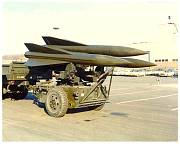
|
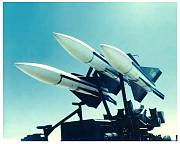
|
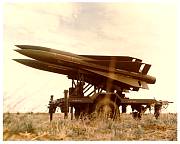
|
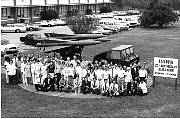
|
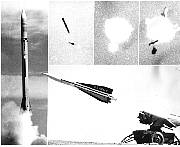
|
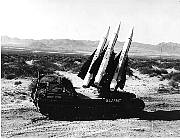
|
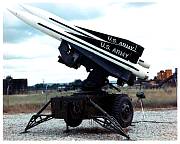
|
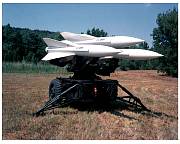
|

|
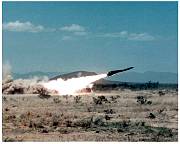
|
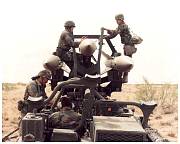
|
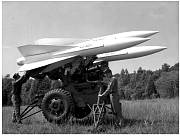
|

|
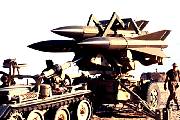
|

|

|
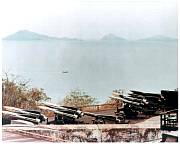
|
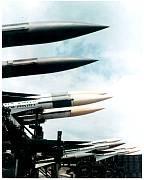
|
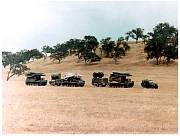
|
